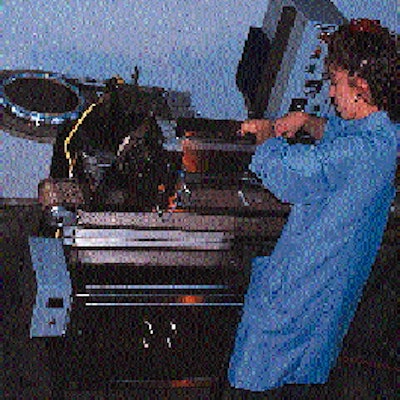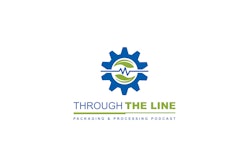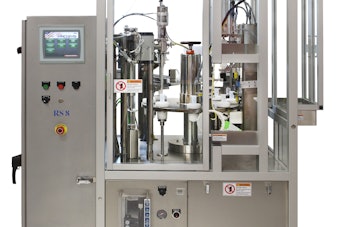
How do they fill "super glue" into those tiny plastic vials? You guessed it, very carefully. So carefully, in fact, that Rancho Cucamonga, CA-based Pacer Technology prefers not to divulge the proprietary equipment that it uses to fill the cyanoacrylate adhesives, referred to as super glue. What the private-label packager is eager to discuss, however, is its late '96 switch from pressure-sensitive labeling to shrink banding for the vials of glue, used by consumers to apply artificial fingernails. Banding is accomplished on a Marburg Industries (Vista, CA) Model M-125-HVD shrink-banding machine, customized for the 23/4"-L vials that are injection/blow-molded of medium-density polyethylene by several suppliers. The change: * Enhances shelf appeal, * Increases speed to 100/min (120/min soon) from 40/min, and * Extends shelf life by increasing barrier. A major reason for the change, insists maintenance supervisor Richard Leist, "is that the shrink-banded vial is more aesthetically pleasing than labeled vials." That's especially important for this cosmetics product, which is sold at retail, often as part of a kit that includes nails and gloss. "Until late last year, we used a semi-automatic machine to apply a pressure-sensitive label to each tube," explains Leist. "We were able to label about 40 vials a minute." Now, he says, "we can shrink band about 100 of these vials, or 'bullet tubes', per minute. As we become more experienced running the machine, we believe we can produce as many as 120 a minute." Filled and capped vials are manually placed into the hopper of the Marburg machine. The hopper holds between 500 and 700 vials in a horizontal position. "Because the bander operates so fast, the magazine runs out quickly and we need a person to regularly feed the tubes into the magazine," says Leist. The hopper gently agitates the vials, feeding them into a rotary drum mounted beside the hopper. The drum measures approximately 7" L and is 10" in diameter. The drum contains more than 30 "nests," each capable of holding a single vial. As the drum rotates, an air jet blows the vial into a band of polyvinyl chloride. Unlike vertical banders, this machine applies the band in a horizontal position around the vial, which is also held horizontally. The flattened tubestock unwinds into the opposite end of the drum. The machine perforates the material to help consumers open the film. The bander maintains material registration so that cut length is identical for each band. Just before the cut, the machine opens the flat tubestock to accept the vial from the opposite side of the drum. Once the vial is air blasted within the tube, a spot heater shrinks one small area of the band near the cap of the vial. By doing this, there's no movement of the vial within the band. As the vial reaches the bottom position of the continuously rotating drum, the vial drops onto a mesh conveyor. Vials are conveyed through a shrink tunnel for less than 3 seconds, at temperatures in the 300°F to 350°F range. Shrink-wrapped vials are then manually placed into corrugated boxes. Boxes are placed in outer corrugated cases and shipped to private-label customers.


















